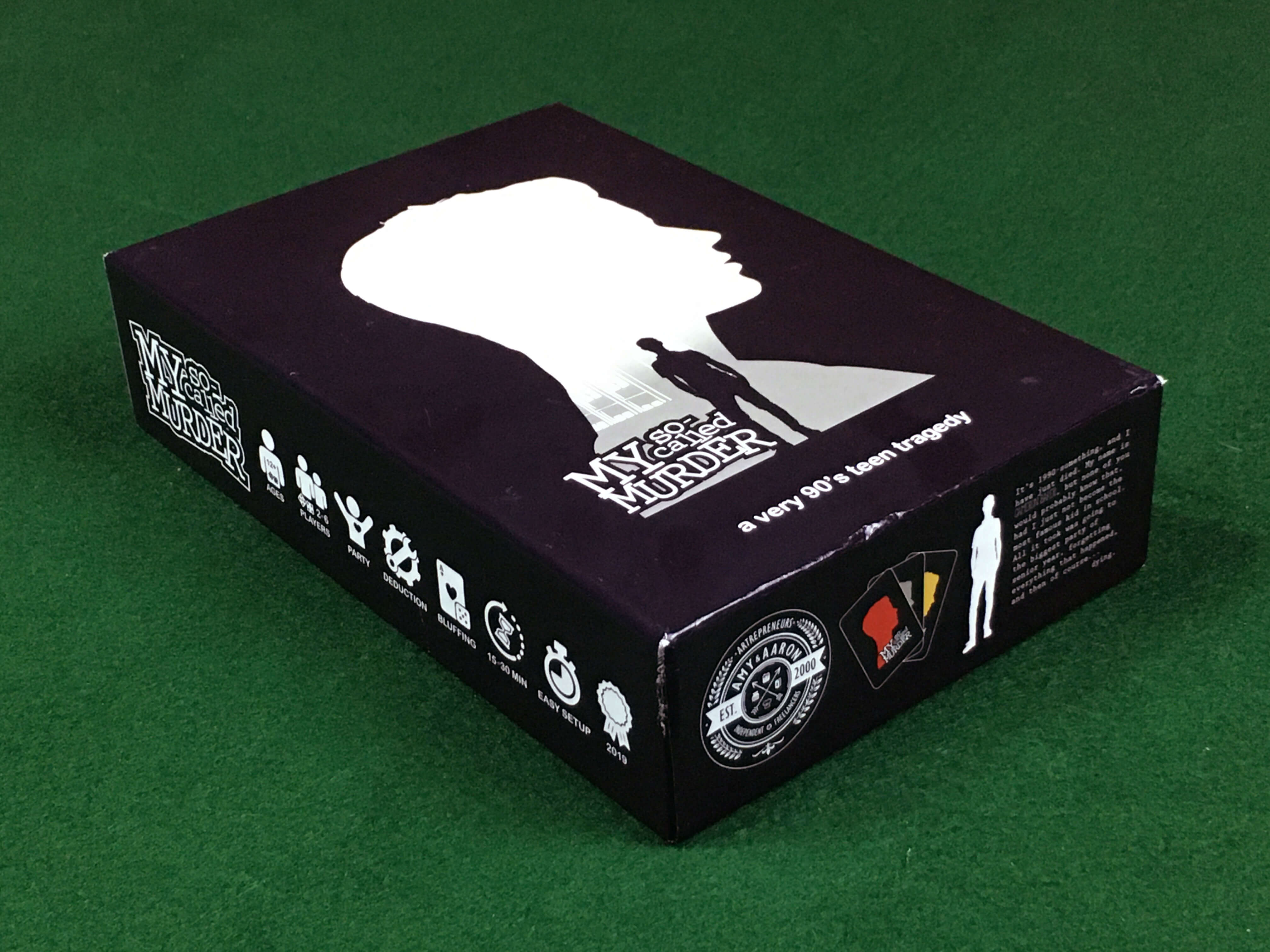
My So-Called Murder is a game by Amy & Aaron that uses the deduction of Clue combined with the bluffing of Coup and casts the players as witnesses dealing with the aftermath of “a very ’90s teen tragedy.”
The story is that the self-labeled loser, Cameron Baker, finally got invited to a party with the cool people. Unfortunately, by the end of the night, he died.
His fellow classmates are trying to piece together what happened, and his ghost is still hovering around trying to remember the events of his own death.
This is one in a series of seven articles outlining my judging decisions for the finalists in The Game Crafter‘s social deduction game design challenge. You can see the full article list here.
Visit Gamified Content’s YouTube channel to watch my review of My So-Called Murder’s shop page from the semi-finalist judging round.
High-Level Review
This game has a cool, thematic art style and an intriguing premise. Unfortunately, the game play itself was clunky and our play through was a bit of a slog. The bluffing didn’t come out much at all, and using the popularity tokens as currency for buying card information felt more time consuming than expected.
Adding a player aid to make bluffing possible for first-time players could make a huge difference in getting the desired experience to come through.
Components
This game uses the medium stout box with only the top and sides printed. The box is very sturdy, and it has more than enough room for all the components. As you can see, The Game Crafter packages components for games using the medium stout box in plastic zipper bags hand-labeled with the order number.
The cover art for the game looks interesting and does a good job of conveying the mood and theme for the game.
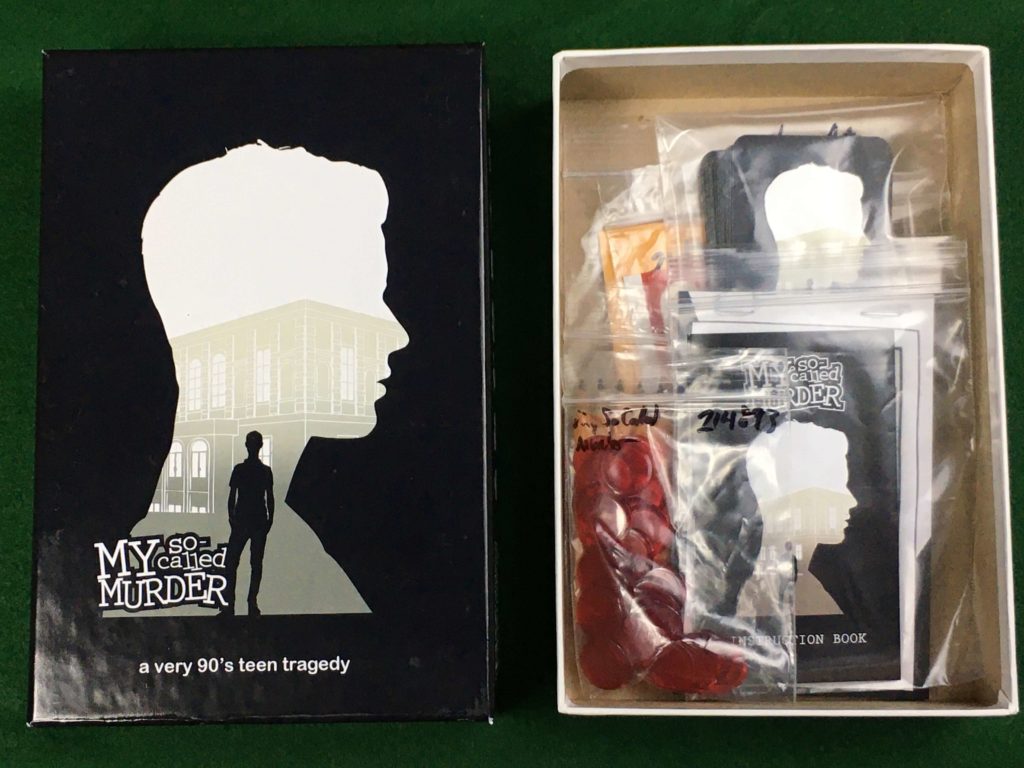
When using the medium pro box with only the top and sides printed, the bottom half of the box (and therefore the back) is covered in white. Printing the box this way saves $1.00 off the component cost.
I double checked, and all the components for this game definitely fit in a small stout box, which would save another $1.00 off component cost and include a printed back (small stout boxes don’t have an option for printing only the top and sides). The designers may have chosen to use the medium stout box to give the game a better shelf presence, which I also think can be a valid thing to prioritize.

Since the designers opted to save money by not printing the box back, they made sure to put all the important game information on the sides. They have all the stats for play time, player count, and age range as well as a small picture of the cards, a well-crafted logo, and some brief info about the game’s setting. They’ve even included icons to call out the types of mechanics used in the game. The print explaining the story for the game is a bit small and hard to read (especially for the font used to highlight Cameron’s name), but overall, the graphic design on the box sides is really well done.
I also think the QR code linked to the game’s TGC shop page is a nice touch. If anyone plays this with a friend that loves it, they can invite their friend to check out the shop page by using the QR code.
While I think using a QR code is a cool idea, I would recommend putting a label next to the code that explains what page you should expect to land on when you use it and maybe even a printed link below it that people who have trouble using the QR code can fall back on.
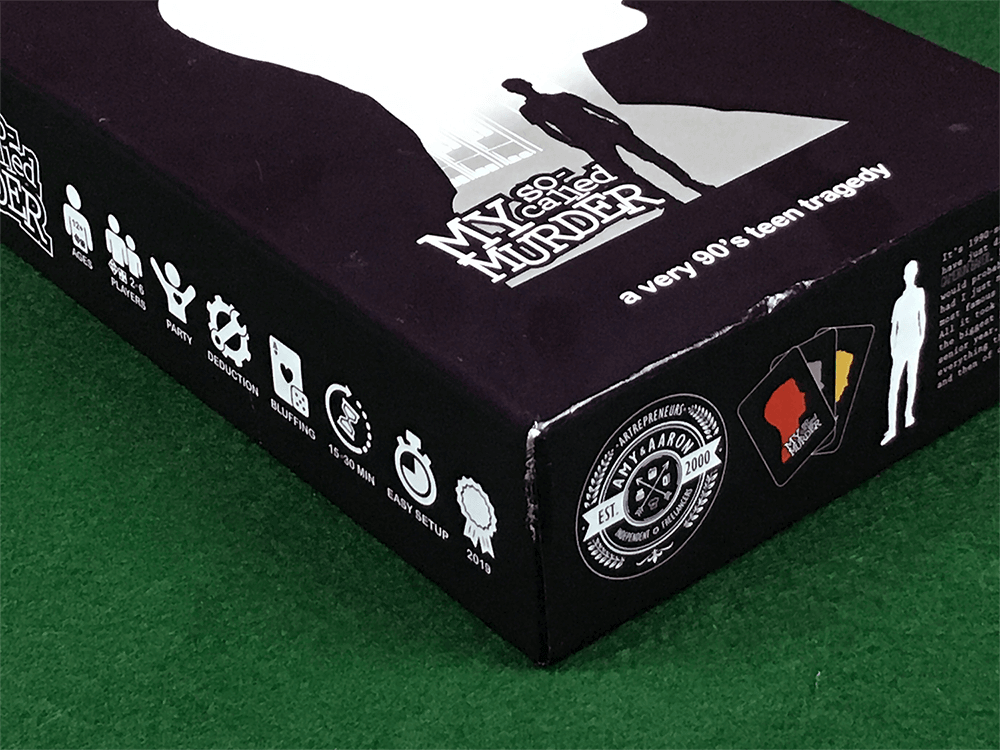
The box includes several bits other than cards. It uses winks for the popularity tokens and comes with pencils and a score pad for tracking the cards you’ve seen. It has a card envelope for the 3 solution cards and one small sticker you can attach to the envelope that says “Permanent Record,” which I thought was a nice thematic touch.

One issue with the design for these cards is that black borders on card backs show wear very easily. This creates noticeable marks after only a couple of plays. In a bluffing game or deduction game where everything hinges on the information on players’ cards staying hidden, these marks can cause game play issues.
Pure white borders would have a similar problem of easily getting grimy from the dirt and oil on players’ hands. The classic playing cards used in casinos have full-bleed patterned backs. This is the approach I’d recommend for the border on these card backs.
There are 3 decks with different backs for whodunnit, wheredunnit, and howdunnit, plus 3 failure cards with a fourth unique back. The rule book is cute and tiny with very polished graphic design inside.
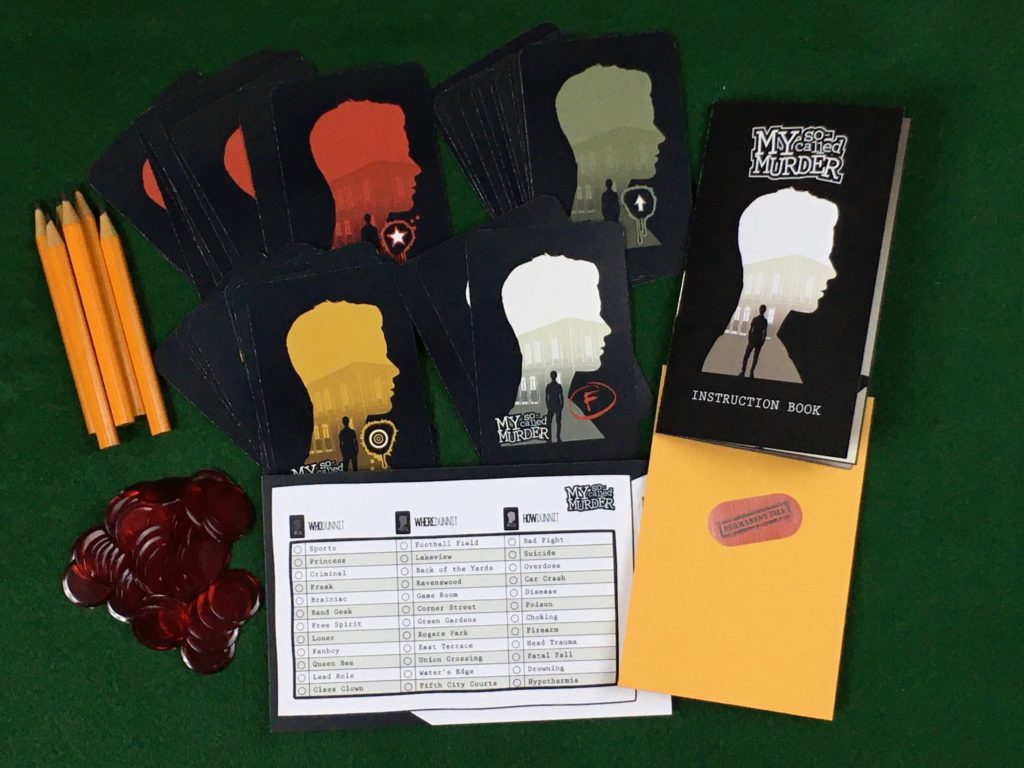
Let’s take a closer look at each of the card types.
The ones with the red backs are the whodunnit cards. They all have a different guest from the party Cameron attended the night he died. Along with the color, the star icon also marks these as whodunnit cards on both the back and top left corner, which will help anyone who is colorblind keep everything straight.
There are 12 of each type of card, and this set has a wide variety of high school trope personas. The art style is unique and interesting, and the portraits have a lot of character.
Each card also has one or two special abilities listed at the bottom. All of the wheredunnit and howdunnit cards have these special powers on them as well, so all of the cards in your hand serve the dual purpose of helping you narrow down the solution and giving you powers.
The print on these cards is a bit too small and hard to read. The font for the headings is especially thin and even harder to read than the paragraph text. It was a big enough issue in our group that multiple players grumbled about it, so I would definitely recommend enlarging it as much as possible.
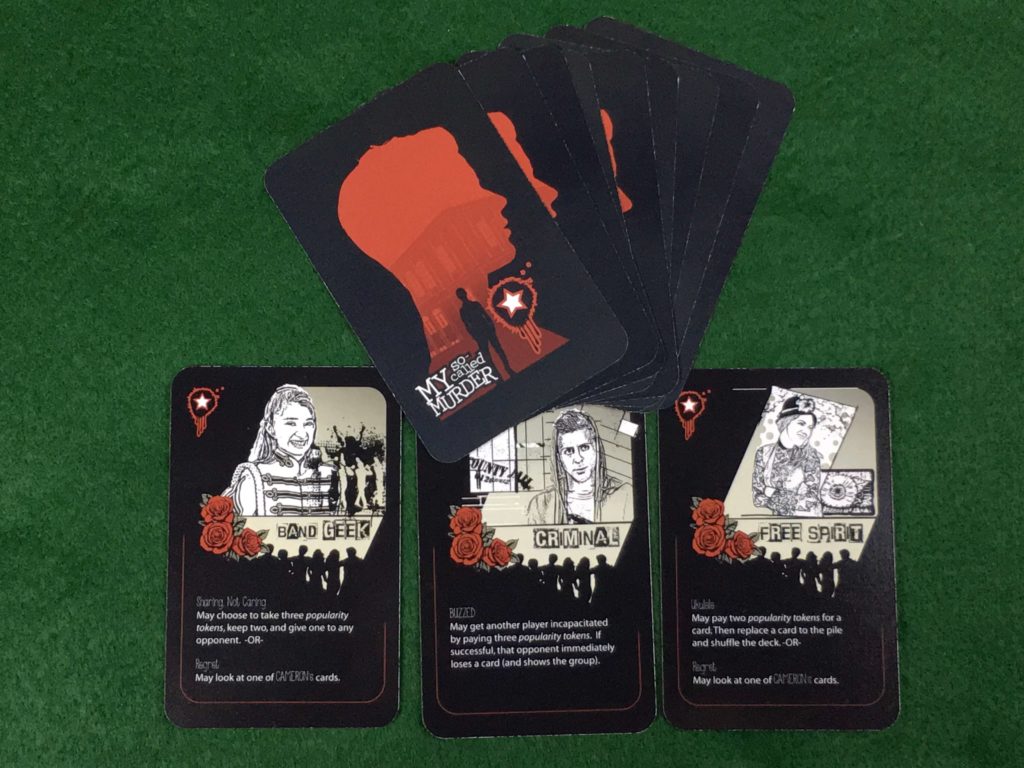
The wheredunnit are very similar but with locations instead of people. They have a gray back and a different icon.
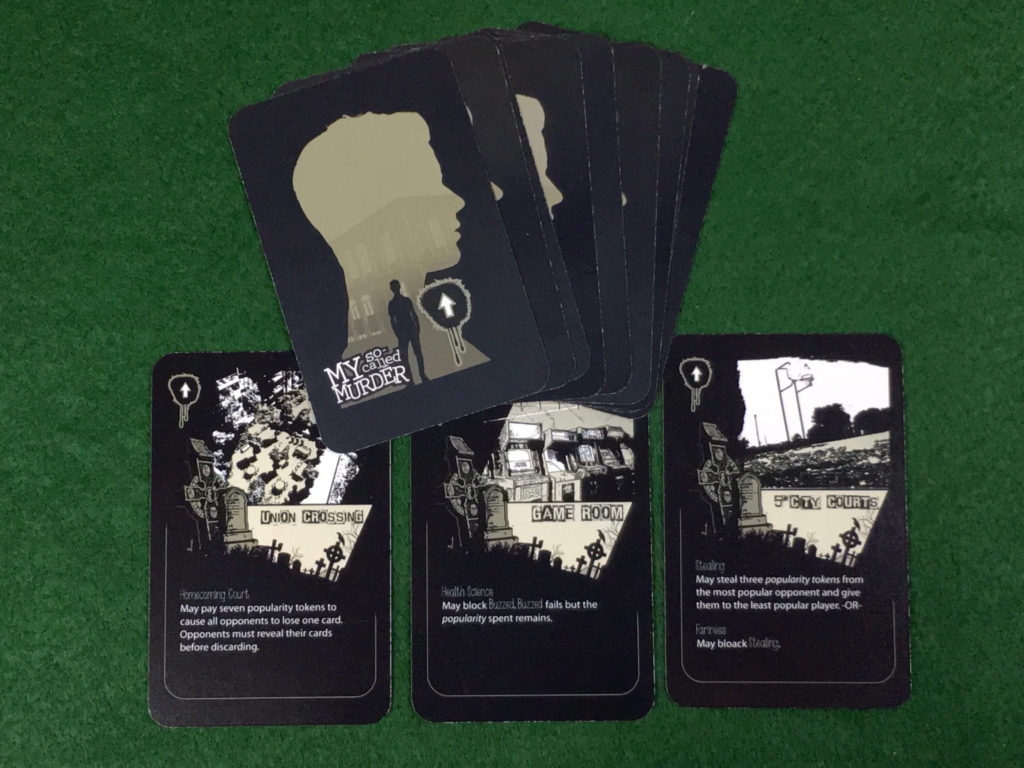
The last set are the howdunnit cards with yellow backs and a mode of death.
Several of the modes of death are more like accidents than ways of murdering someone. One of them is even explicitly labeled as Suicide. I guess that’s why this game is titled My “So-Called” Murder. 🙂
I will say, though, that teenage death, especially through suicide or overdose, is a pretty heavy topic, so I think it could be a good idea to include a disclaimer somewhere in the game saying that suicide and the opioid crisis are real issues facing US teens and adults alike — and help is available from your local medical professionals if you or anyone you know is struggling. It could be on the box, rule book, or maybe on an extra card or two from the 3rd sheet of 18 US game deck cards the game isn’t using anyway.
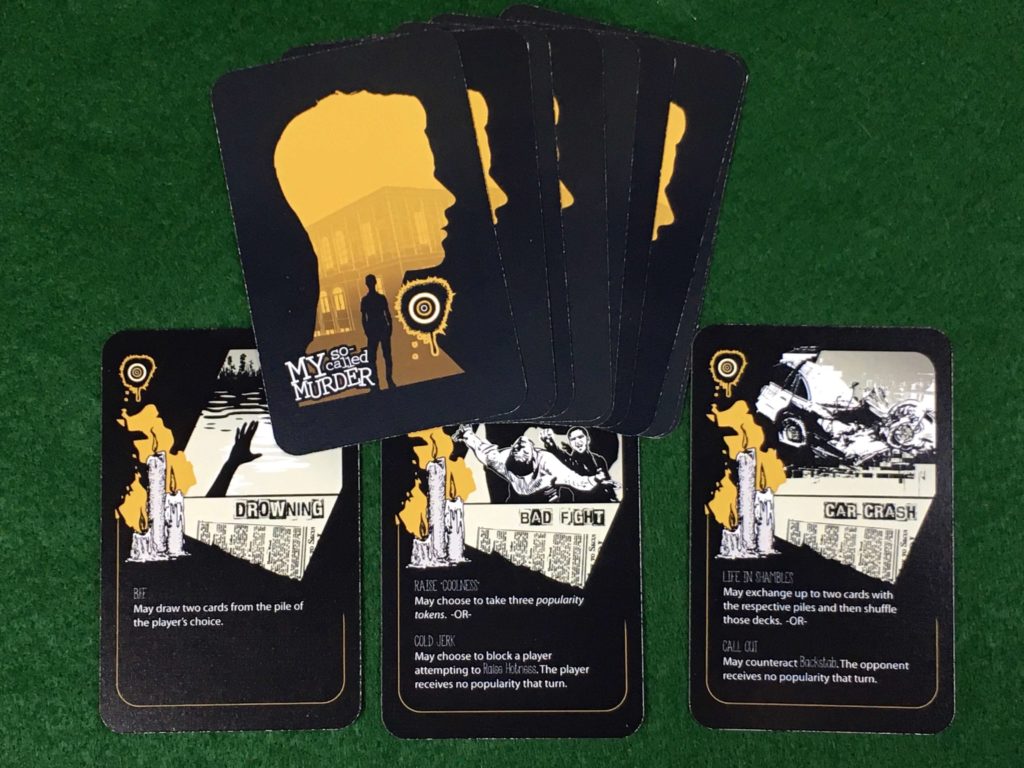
There are also 3 Failure cards with white backs and circled red Fs. The instructions say to shuffle one of these into each deck. As with the other cards, the writing on them is a bit too small and difficult to read.
Our group didn’t understand why the backs of these cards were different than the others. We felt that we would have preferred to have one with a red back, one with a yellow, and one with a gray so that we could still bluff as having a card with a different power.
Plus, as you can see in the image below, the failure cards block actions or counteractions. It seems like it would be much more useful to have a counteraction card if I could keep that secret.
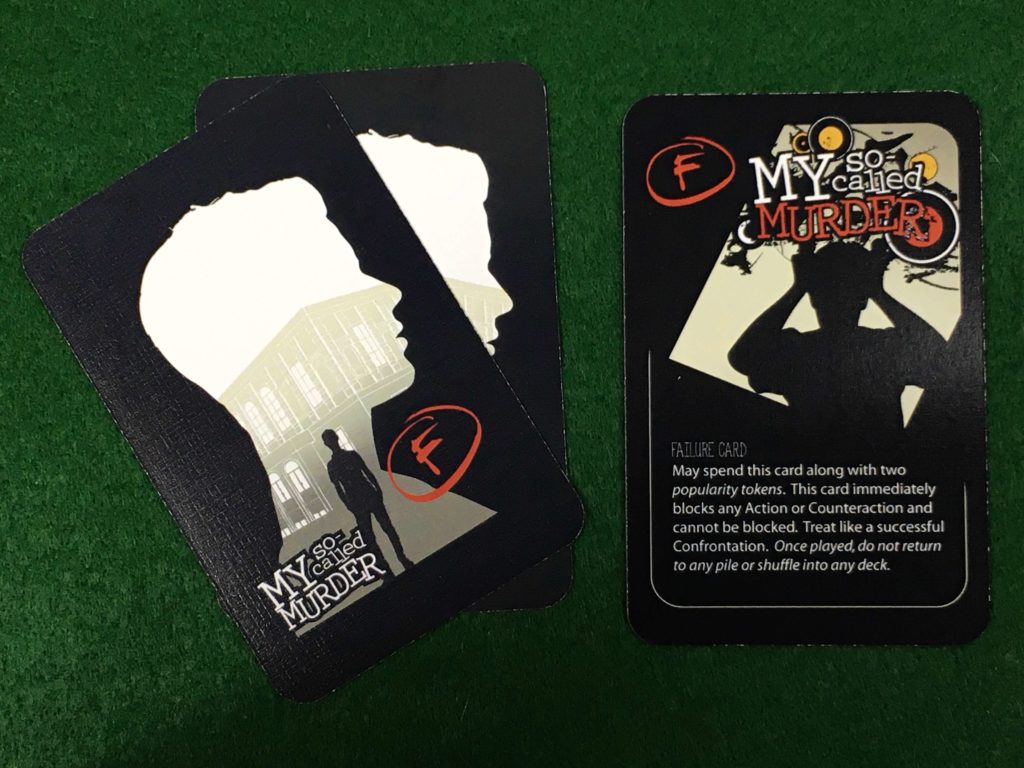
For those of you who have played Coup, you may remember that each player in that game has a reference sheet with all of the possible powers. This makes it easy to say, for example, “I’m the Duke, so I’m taking 3 coins,” whether or not you actually have that card in your hand. In fact, the persona cards in my copy of Coup don’t even have any words other than the title of the card. All the instructions are on the player aid.
My So-Called Murder has 12 personas, each with a unique power, so there’s a lot more to keep track of compared to the 5 powers included in base Coup. The ability on each whodunnit card is copied to one wheredunnit and one howdunnit card so that there are a total of 12 special abilities in the whole game.
The sets of whodunnit, wheredunnit, and howdunnit cards are loosely thematically tied, but one of them in the solution doesn’t necessarily mean the matching cards are also part of the solution. For example, Sporto could be the whodunnit without Football Field as the wheredunnit.
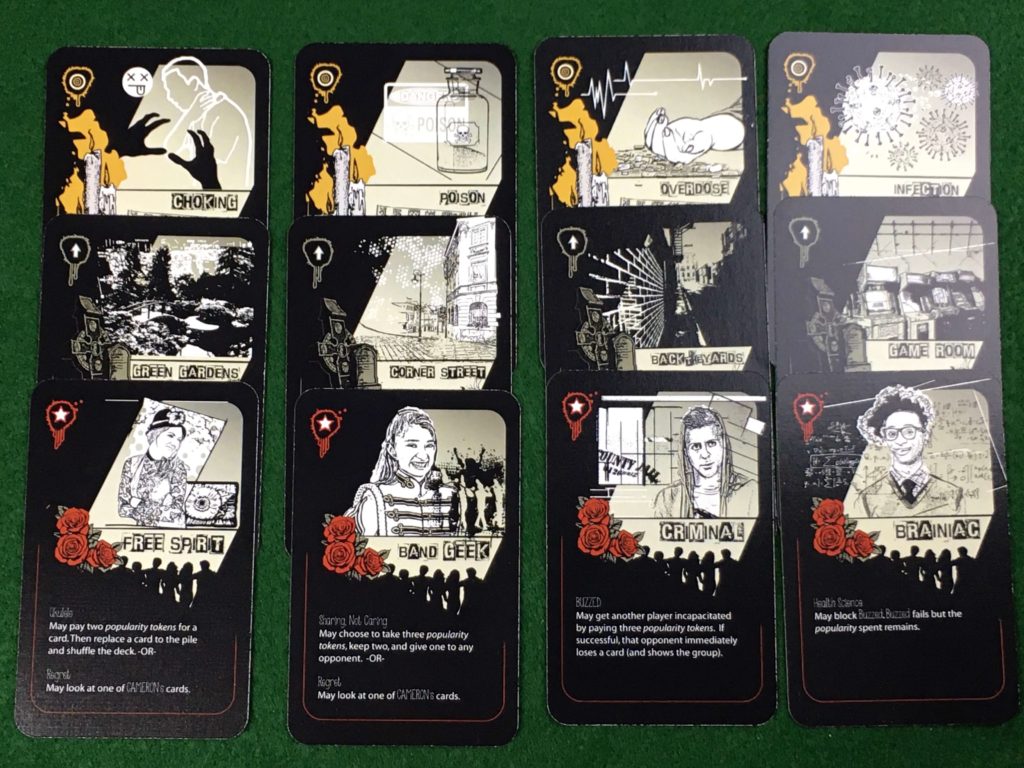
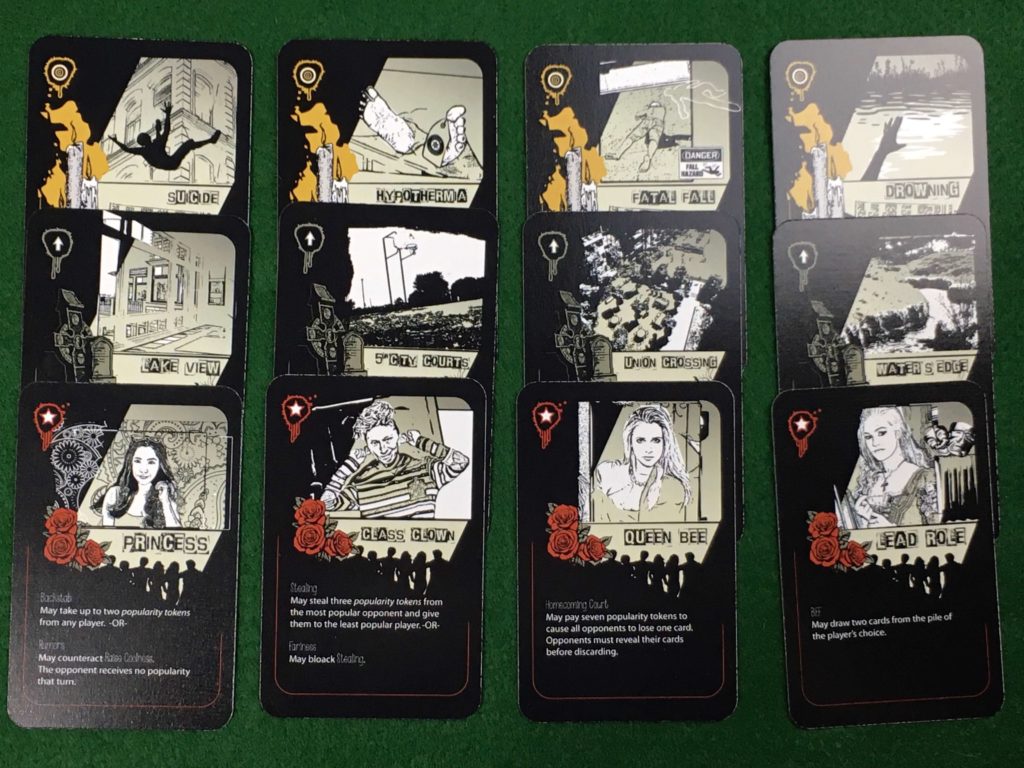
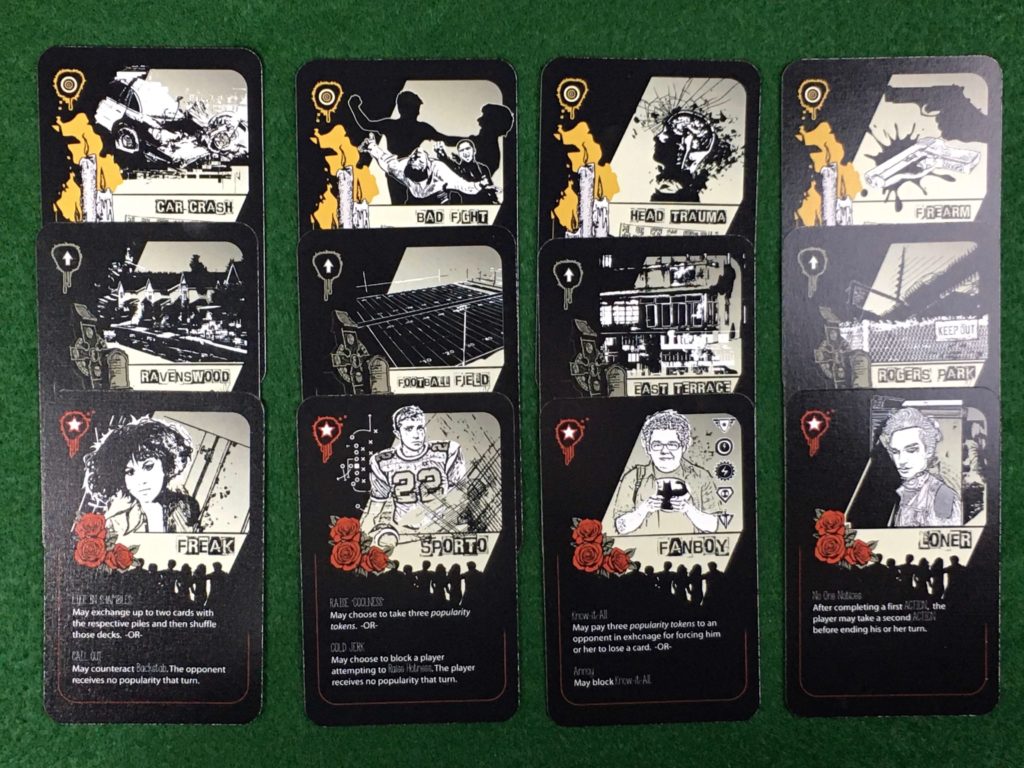
The sets of card abilities are neat and thematic, but in my opinion, without a player aid listing all of the possible abilities, the game play is taxing and confusing. The bluffing isn’t able to come out much when you need the card itself in your hand to know the power exists in the first place.
Game Play and Mechanics
The TGC shop page for this game says the goal is to make a game with the deduction from Clue without the tedious roll-and-move aspect. Since Coup is a quick and light game with a lot of intrigue, I can see why it would seem like a good stand in for Clue’s roll-and-move mechanic.
In practice, though, using the popularity tokens (similar to the coins from Coup) to buy information often felt like a slog. With the cost of most methods of gathering information averaging about 2 popularity points, it seemed like we used more than half of our turns to simply gather currency and pass to the next player.
I think part of the reason the persona abilities in Coup work is that the entire game is about earning enough coins to attack and eliminate other players. This means that paying attention to how many coins others have (and stealing them as much as possible) is critical to your survival.
In My So-Called Murder, the win condition is deducing the answer to a puzzle by seeing as much information as possible. This means that, when you get enough popularity points to interact with the puzzle, you’re only getting one small piece you need, and the progress is really slow.
If there were reference cards with all the special abilities and which whodunnit, wheredunnit, and howdunnit cards they go with, players could combine their ability to read people with the record of cards they’ve seen to narrow down the answer without seeing every card. It’s also possible this would create a lot of analysis paralysis, but play testing would make this more clear.
Maybe it could speed things up if the “Allegation” action (guessing a card from a player’s hand and getting to peek at one card you guess correctly) could become a free action, since it’s not guaranteed to pay off anyway.
There is an action option called “Bump Into” that our group couldn’t understand why you’d want to choose. For this action, you pay one popularity token to shuffle Cameron’s ghost hand, which starts the game with one of each card type (all with different backs).
Since the ghost hand only has 3 cards, in practice, it was easy for it to end up arranged as 3 cards lined up on the table rather than a stack with a “top” card — especially considering the instructions told us to lay our own “hands” down in a line on the table.
There is a special ability that allows you to look at any one card in Cameron’s ghost hand. It’s unclear if the person who uses this ability is required to keep the pile in the exact order it was in before. Since the backs are different for each card type, it doesn’t seem like shuffling would have much effect on this.
The only other way we saw to interact with Cameron’s hand was when you’ve made a guess at which cards another player has and been wrong on all counts, you trade a card from your hand with the top card of Cameron’s hand. Since the failed guesser can only trade with the top card of the ghost hand, the shuffle could have some impact, but it’s hard to imagine that impact being worth the cost of one popularity point.
Of course, once one of these exchanges happens, I think it’s supposed to be allowed for the ghost hand to have, for example, two cards with red backs and one with a yellow back, so shuffling would have more impact on the special abilities that interact with the ghost hand in this case.
However it’s also very possible that Cameron’s hand will have one of each type of card for the whole game, and it’s not easy to randomly shuffle cards you can see the difference between. It was unclear to us if the player who shuffled was allowed to ultimately arrange the cards whichever way suited them or if they were expected to truly randomize them by holding them under the table while shuffling.
Lastly, our group was unsure if losing all of your cards is supposed to mean you’re out of the game. The rules don’t say that losing your last card eliminates you, but, since the game is modeled after Coup, and losing your last card in Coup does mean you’re out, we weren’t sure if player elimination was the intention. Whether players are supposed to be eliminated or not, it would help to explicitly state in the rules what is supposed to happen if a player’s hand is ever empty.
Scoring
The following scoring breakdown is based on a rubric I released during the game design challenge on TGC’s contest page. All sections are worth a maximum of 1 point.
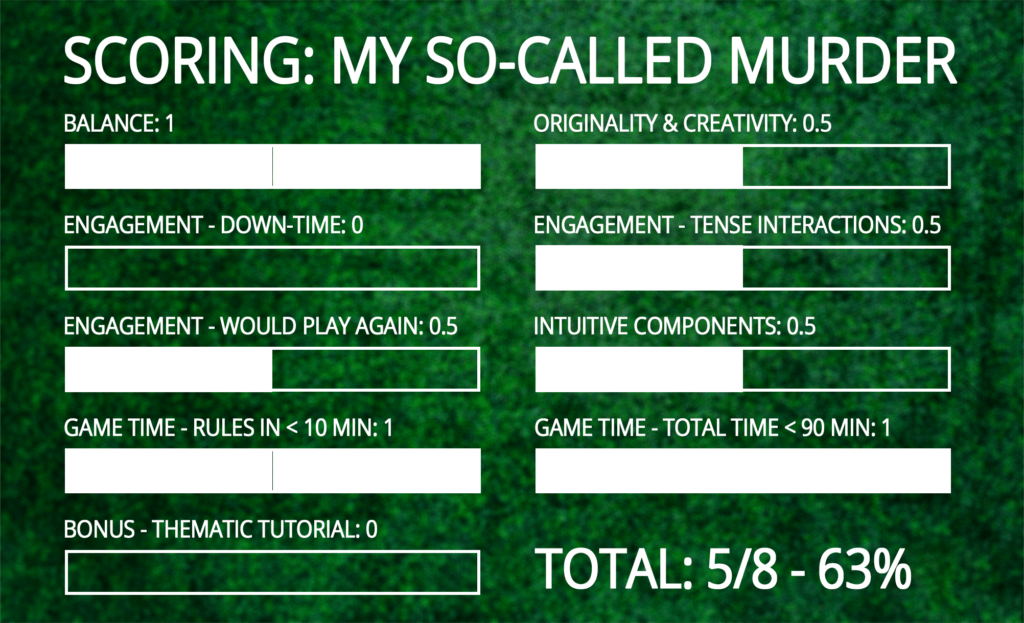
Balance: 1
We all felt we had an equal chance to win this game. Since this game doesn’t have teams or a “traitor,” there wasn’t much chance for the roles to seem unbalanced.
It’s possible that some of the specific special abilities are overpowered, but, not having had full knowledge of all the possible special abilities while we played, none of them obviously showed through as overpowered in our game.
Originality & Creativity: 0.5
Since this game is a mash-up of the primary mechanics from two fairly mainstream games, it doesn’t feel fair to give it a blanket label of “original.” However, it does have a lot of creative and thematic ideas and names for actions paired with their characters along with lots of unique and interesting art, so I feel it still deserves some credit in this category.
Engagement – Down-Time: 0
While playing this game, I felt like I was simply waiting for something at least 50% of the time.
I didn’t expect to feel a ton of down time since the actions available to each player on their turn are all simple and quick. The individual turns do mostly go fast. However, because I needed to spend so many of my turns collecting popularity points, even when it was actually my turn, what I spent my turn doing was uninteresting, and I still mainly felt like I was in the middle of waiting for the chance to make progress.
You could also say there is ample opportunity for constant interaction since you can call other players’ bluff on special abilities. The problem was, without a public list of all possible special abilities or an easy way to reference the makeup of the cards available in the deck, our group felt constantly lost on whether or not we should risk calling someone’s bluff.
Engagement – Tense Interactions: 0.5
Even though we didn’t have full knowledge of all possible special abilities, we did our best to pay attention to the action names people were sighting and copied each other. We also had a few instances of calling one another’s bluff, so we did interact some, just not as much as we would have liked to.
Engagement – Would Play Again: 0.5
Although I would not play the game as written again, I would be interested to play a future iteration. The theme is interesting, and I like the idea of a “Clue variant” with the board removed and mistrust between players added.
Intuitive Components: 0.5
As outlined above, the cards had nice art and a functional layout, but the writing on them was hard to read. The white card backs for the Failure cards seemed counterproductive.
Most importantly, the game desperately needs a publicly available reference list for all the possible abilities.
Game Time – Rules in under 10 min: 1
The rules are fairly straightforward and the rule book is easy to reference. I didn’t have much trouble explaining it and getting everyone started.
Game Time – Total Time under 90 min: 1
Although the game felt like it was dragging on, we were able to finish it within 90 minutes. It might be good to aim for a play time of 45-60 minutes with this game, though, since it claims to be a snappier version of Clue using the bluffing from Coup, and Coup usually doesn’t take more than 30 minutes.
Bonus – Thematic Tutorial: 0
The theme of this game was great, but there was no tutorial mode that used theme or story to help walk players through the process of learning how to play.
Total Score: 5/8 – 63%
You can see the scoring breakdown for all the semi-finalists and finalists in this game design challenge in my public scoring spreadsheet.
Credits
Thank You to my Loveland Meeples Play Test Crew
Michael Bignall, Keith Kemerer, Will Newton, Todd Reidenbach, and Bryan Robert
Leave a Reply